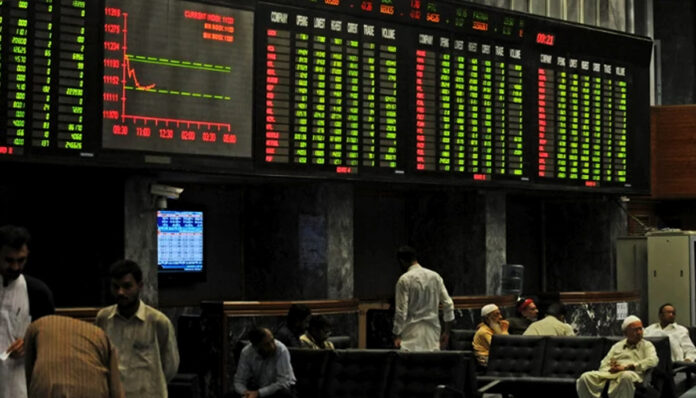Recently, there has been news regarding how many of the brokerage houses of the Pakistan Stock Exchange (PSX) are converting into the category of ‘Trading Only Securities Broker’. What do these buzzwords mean and what does it mean for the market and investors? Profit explains.
Fallout of crisis
Since the last market crash took place in 2008, there have been different lessons that have been learned by the PSX in order to better manage the risk and the assets of the clients who are active investors in the market.
To understand the crash better, read Profit’s detailed story on what led to it and its aftermath.
Two of the most important steps that have been implemented are segregation of assets and placing of securities brokers into categories. Due to these measures being implemented, it has been assured that the clients’ assets are protected from misuse and the risk associated with brokerage houses does not cause undue volatility in the market. Let’s break down both these measures further.
Segregation of assets
Let us take you back a few years on how the PSX (then Karachi Stock Exchange) used to operate in the old days. Clients or investors would go to a broker who would open a trading account for the client which was like a bank account.
This account would be used to keep a record of shares and funds that the client had invested on his own through the broker. It was a simple ledger that was kept by the broker to keep track of all the transactions that were being carried out.
As this was a time of low regulation and monitoring, many of the brokers kept the shares of the clients in their own custody account. These custody accounts are opened in and managed by the Central Depository Company (CDC).
The CDC is a company set up specifically to be a custodian of the shares of an investor or a brokerage house and has the sole responsibility to make sure shares are protected and kept with proper accounting and monitoring.
Just like a bank is a custodian of deposits of its customers, the CDC only deals in safekeeping of shares. But unlike banks, the regulatory framework at the PSX was close to non-existent at the time and brokers were able to keep the shares of the clients in the name of the brokerage house, not at the CDC, for personal use. A practice akin to stealing.
This was done while the clients were unaware of how their shares were being used and because they got no notifications from the brokers or the CDC when a movement of shares or use of funds was carried out, they were simply unaware of this daylight robbery.
As brokers were using the shares of the clients without their knowledge, this was seen as a giant breach of their fiduciary responsibility. The clients’ assets should be under the ownership and control of the clients themselves. This was not the case here.
Imagine a bank withdrawing money from the clients’ account in order to pay their expenses. Doesn’t sound right does it? The brokers were freely using the clients’ assets, both funds and shares, for their own use and when these brokers defaulted, the clients’ assets were lost as well.
What changed?
The Securities and Exchange Commission of Pakistan (SECP) and PSX made the necessary changes to laws specifically after the 2008 market crash in order to make sure clients were not disadvantaged by the brokerage houses. SECP and PSX made it mandatory for brokerage houses to ensure segregation is maintained and that all assets of the clients are separated from the operations of the business-side of the brokerage.
The SECP and PSX made sure that brokers could no longer use the clients’ assets for their own personal consumption. It was created to have a barrier to the sweet honey pot of funds that the brokers thought they could use whenever they wanted.
Brokers were kept in line through regular audits and they had to make submissions to the PSX and SECP regularly and periodically. This was the first step that was put into place to make sure the brokers were not risking the clients for their own benefit. The next step in risk management was to make sure the market was kept safe from brokers as well. This led to the categorisation of the brokers.
Categorisation of brokers
As the capital markets of the country have matured, measures have been taken to make sure that the client as well as the market is protected and looked after. In many of the crises of the past, the investors and the market are the ones who lost out. The SECP and PSX are constantly making sure that there is a firewall around the investors to protect them and their assets at all and any cost.
A recent step taken to solidify that firewall was to classify brokers into three separate categories.
These categories are namely trading only, trading and self-clearing and trading and clearing. In order to understand the significance of these measures, it is important to understand what used to happen before.
Trading before categorisation
When a trade is carried out at the stock exchange, it is not like a real estate or property deal. When a property deal takes place, the buyer and seller know each other and are able to exchange the property or money face to face knowing full well who all is involved in the transaction. In the stock exchange, an investor has an interaction with a computer screen interface rather than a human being. The trades are carried out between two anonymous parties.
Let’s say someone wants to buy shares from the market and is successfully able to do so during normal trading hours. The client now has to make sure that he has the required funds in his trading account to settle what he owes for the purchase of said shares. The usual settlement time in the stock exchange is ‘T+2’ or trade + 2. This means that the buyer will get the shares two days later and has to arrange for the payment in 2 days time.
Two days later, the money will be withdrawn from his account and will be deposited into the seller’s account and the shares will come into the CDC account of the buyer after they have been withdrawn from the CDC account of the seller.
But it is not as simple as that. There is a clearing house, National Clearing Company of Pakistan Limited, that is in the middle of this transaction that clears these trades and facilitates the transfer of funds from one account to another. It is an autonomous body which has been set up for facilitating trades. It has been created separately as they have access to the trading being carried out and that kit needs to be kept confidential.
Role of clearing house
The role of the clearing house is to sit in the middle of each and every transaction and make sure there are funds and shares that can be cleared or transferred from one account to another in a seamless manner. In such a case, both parties are showing that they can honour their respective commitments and the trade will be carried out.
In case this does not happen, and let’s say the buyer of shares is unable to come up with the required cash in the T + 2 settlement time; the NCCPL reprimands that side while the one that follows through on its commitment has their trade take place. Usually, trades go through most of the time so NCCPL is able to do its job efficiently.
The role of NCCPL is important as it is able to facilitate the task of clearing or being the middleman who is responsible for clearing thousands of trades on a daily basis.
In order to make sure the brokers are able to carry out trade, the NCCPL keeps a certain amount of exposure.
This exposure is like a collateral or a fund that allows brokers to trade up to a limit. Just like collateral can be used in case of default, NCCPL can use this exposure to recoup some of the losses which take place. This can be in the form of shares or cash. Once that limit is crossed, the broker cannot trade any further. This is a fail safe mechanism that makes sure no broker is trading quantities in the market larger than it can back with capital.
It acts as a tool of risk management to ascertain the buying or selling capacity of a broker. The higher the exposure, the more their capacity to trade large quantities and clear these trades by themselves.
Phasing in of categorisation
In order to protect the stock market from shocks created by individual brokers, the exposure limit is a mechanism that makes sure brokers are not carrying out large sized trading in their accounts. In the past, the assets of the broker were the threshold but now PSX has mandated for brokers to be broken up into three categories depending on the size of their balance sheets.
This has been done by the PSX to ensure that small brokers do not hold clients’ assets for which they do not have the necessary capital to back those assets up. If they default, the PSX wants to protect the clients and their hard earned earnings.
Trading only is the first category which means a broker can trade for themselves and carry out trades for their clients, however, they cannot clear these trades in the market. In order to facilitate the trading, there is a professional clearing member (PCM) whose task is to clear the trades for these small brokers. As a simple example, imagine the PCM as being the bouncer at the door for the small broker. The PCM makes sure that trades are only carried out when the broker and their clients have the necessary funds or shares to honour the trade.
Small brokers do not have a large amount of capital on their books and have small balance sheets. As they have a small capacity of funds, they cannot hold their own shares or the shares or the funds of his own clients as well. If the broker defaults or wants to exit the PSX, the clients’ assets are stuck in a legal limbo . Under the new system, as the PCM keeps custody of the shares of the clients, the assets are protected.
Trading and self-clearing brokers is the second category where a broker can trade and also clear all the trades being executed by him. They have a bigger balance sheet in comparison to a trading only broker and this allows him to hold his own proprietary shares and assets of his clients on their own books. Such a broker is seen to be much more stable compared to a small broker and that is why they are allowed to clear their own and their clients’ trades.
Lastly, there are the trading and clearing brokers who are similar to the second category but additionally, they can also clear the trades of other securities brokers and their clients and get to have custody over the shares and funds held by these brokers and their clients as well.
This means that they have the ability to hold these assets in their accounts and can charge a fee for providing these services. It also means that the client or broker needs to tell them when to move these assets around.
These are mostly the big guns of the market and due to their size, they are able to clear a larger scope of trades. They have low risk of default or being declared bankrupt and get to see a higher volume of trades come their way due to that fact.
Purpose and trend of categorisation
This new categorisation system was introduced to make sure that when brokers trade for themselves and their clients, they should have the financial resources to clear, or back these trades up with their own capital.
If they are too small, they have a risk of defaulting, so it is better if the trades being carried out by them are cleared by a middleman who will also keep custody of the assets to make sure clients are protected in case of a default.
The recent trend has been to make sure that brokers are allotted the proper categorisation in terms of their asset base. This ensures that even if the broker defaults, the assets of the clients are protected. Having accounts with the PCM also means that in case a broker defaults or cannot trade anymore, the client can move easily to another broker and carry out their trading with little to no interruptions or hassle.
That there hasn’t been a major crash since 2008, after which these regulations and changes were put in place speaks to their effectiveness. However, this is no reason for any complacency in the matter. Monitoring, evaluation, identification of flaws, their resolution and improvements in systems should be consistent and constantly taking place to ensure clients’ investments and monet is safe.


























Some potential business ideas in Pakistan include e-commerce platforms, app development, renewable energy solutions, organic farming, and tourism-related services such as guesthouses and travel agencies.
It’s important to conduct thorough market research and develop a solid business plan before starting any venture. With the right resources, skills, and dedication, anyone can start a successful business in Pakistan.